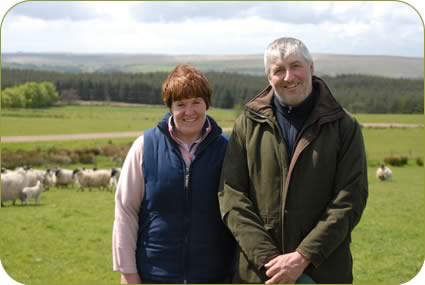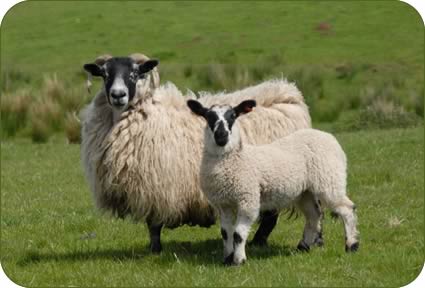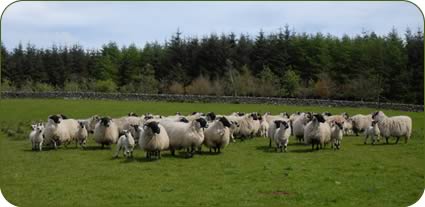Jennifer MacKenzie is an agricultural photo journalist with almost 30 year's experience. Operating from her base in Cumbria, Jennifer undertakes mainly industry-related freelance writing and photography.
Dedicated to the North of England Mule
The backbone of the farming enterprise for David and Marion Hope at Albierigg Farm, Canonbie, is the North of England Mule sheep.
So it is more than fitting that Marion, whose passion is farming and in particular the sheep, took on the role of secretary of the North of England Mule Sheep Association.
 |
| Marion and David Hope and Blackface ewes with their Mule lambs |
Marion took over from Dorothy Bell last spring after 20 years and now she is running the association for its 1,200 members from home as well as working alongside David on the farm and looking after their young sons Thomas and Harry.
The couple took on the 15 year tenancy of the 610 acre Buccleugh Estate farm in October 2006, selling the 130 acre Blackaburn, at Wark near Hexham which had been farmed along with rented ground by David’s family.
The larger unit enabled them to more than double their ewe numbers to 700 and establish a suckler herd of 80 Limousin and British Blue crosses so the farm could support both of them – both Marion and David have HGV licences and previously supplemented their income driving livestock lorries.
Of the flock, 450 are Northumberland type Blackface ewes, 150 of which are bred pure and remainder are crossed with home bred crossing type Bluefaced Leicester rams to maintain the 200 North of England Mules. There are a few Beltex and continental ewes for breeding commercial show sheep for the boys who have each won the Longtown Mart young handlers class with three quarter Beltex lambs.
David and Marion say the sheep they run suits the farm. The continuing popularity of the Mule and its ability to be adapted to different systems is reflected in the fact that Marion has recently posted 2,300 sales booklets to prospective commercial purchasers across the UK from Caithness to Somerset.
“The Mule is the best crossbred sheep for breeding prime lambs,” said
David.
“She will finish two lambs naturally within 12 to 14 weeks. She’s
a great
breeder – consistent and very prolific with the ability to easily
rear two
lambs.”
 |
| Blackface ewe with her Mule lamb |
The Hopes usually sell around 175 Mule ewe lambs each year, retaining 60 to cross predominantly with the Suffolk and some with the Texel. Last year they averaged £91 with the first 100 selling through Hexham, a further 50 sold later and 25 privately.
Mule wether lambs are sold from mid July through Longtown mart. Last year’s first batch of 20 sold on July 16 averaging 42kg averaged £63.80 with the overall average for the year of £66.
The lambs, with the exception of the Blackfaces, are creep fed through the summer, to get them off the farm by October when the weather can turn wet. From six weeks old they are fed a mix of 60 per cent lamb creep pellet and 40 per cent whole barley.
“It’s an expensive way to do it but the feed conversion rate of the lamb while it’s still on its mother’s milk is far better,” said David. “It also gives the ewe more of a rest.”
The Mules lamb mainly to the Suffolk from mid March onwards and by early August only a handful of the finishing lambs are still to sell finished. The Hopes have found the Suffolk to produce the earlier lambs.
Last year the first batch was sold through Carlisle weighing 42kg to average £74.50 and by early August all 220 lambs were sold to average £61.
The Blackfaces lamb from April 1. Lambs are not fed creep because of their horns. They are weaned in mid August and run on grass with feed introduced to get them off the farm by November-December selling through Longtown Mart which also handles the cast ewes.
A small flock of 12 Bluefaced Leicesters are kept mainly for breeding rams for use at home but the odd lamb and shearling is sold with a shearling making £750 at Hexham last year.
The ewes are condition scored when they are dosed for fluke in the first week in January and the larger ewes are fed some concentrate. Feeding the rest begins at the end of January, a mix of two thirds oats and a third cake. Three weeks before lambing they are just fed cake.
 |
| Blackface ewes with their Mule lambs |
After lambing the oats are re-introduced on a 50-50 basis. David believes in feeding the ewes well while they are working hard.
Ewes carrying singles and triplets are lambed in a 125 x 30ft polytunnel covered with wind resistant material, as are the Mules and Bluefaced Leicesters, being housed no more than 10 days before they are due.
The plan is to put up a second 150 x 30ft polytunnel for which they hope to receive a 50 per cent grant from the SRDP under a five year land management programme for the structure and fittings such as drinkers, pennage and feed barriers, which will enable more ewes to be housed at lambing time.
Depending on the weather, they are turned out within 36 hours of lambing
The Hopes carry no passengers and any ewe that is not performing after lambing then she is sold cast.
The flock is closed to minimise disease risks with only Blackface and the odd Bluefaced Leicester rams being bought in.
All the sheep are vaccinated against enzootic abortion and toxoplasmosis as a precaution. Pet lambs are reared on a Volac feeder.
At the summer shows the Hopes won the overall championship at Newcastleon with a Mule against other pure breds and the boys won the young handlers class with a three quarter Beltex. They also won the Mule class at the 2008 Borderway Agri Expo in Carlisle and they have collected the championship at Hexham for the last two years’ NEMSA shows.
The Hopes believe in investing in their stock rams. A ram bought last year from John Snaith at Clennell Hall for £700 has produced sharp, clean Blackface lambs. They look for square types with good mouths and legs.
All the replacements for the suckler herd are bought in through Harrison & Hetherington, generally in one batch off one farm to minimise disease risks. The heifers are either bulling, in calf or with their first calf.
They are all calved to the Limousin bull with some calving in March and April and the remainder in September and October.
The calves are only fed at housing and the cows get some concentrate and ad lib silage.
Calves are sold at nine to 11 months old in Carlisle. The 15 calves sold at the March sale averaged £830 for bullocks to a top of £930 and a heifer average of £754.
One of the regular buyers is near neighbour David Dickinson at Brocketlees, Canonbie, who sells finished cattle to Cranstons butchers.
Since the suckler herd was started, pedigree Limousin bulls have been bought privately from Michael Davidson, of Latter Ford, Wark, which have proven to be very easy calving.
The farm’s only other livestock is David’s Throroughbred brood mare and two Gloucester Old Spot piglets, Chops and Pepper, which were Harry’s birthday present.
As for her new work with the Mule association, Marion says the Mule has been challenged over the last few years and the association is determined to have it back at the top.
The NEMSA website is being re-designed and it will be regularly updated with news and events. Marion has started a forum on Facebook - called Bonny Ewe Lamb Mule Rules - where its members can chat about Mules and put up photos.

